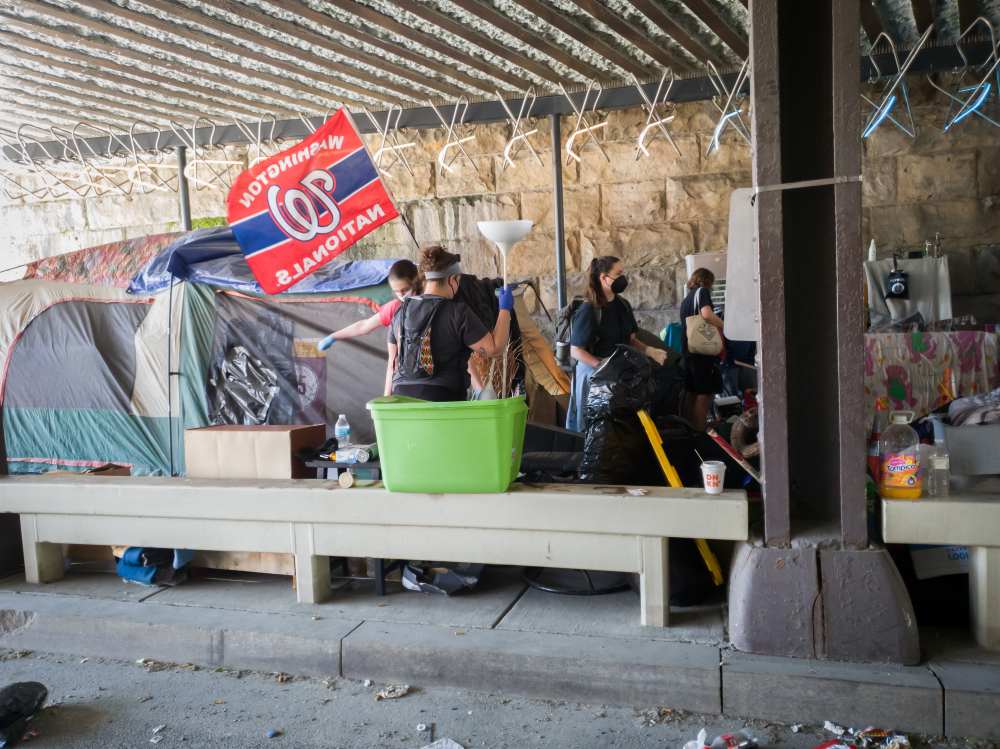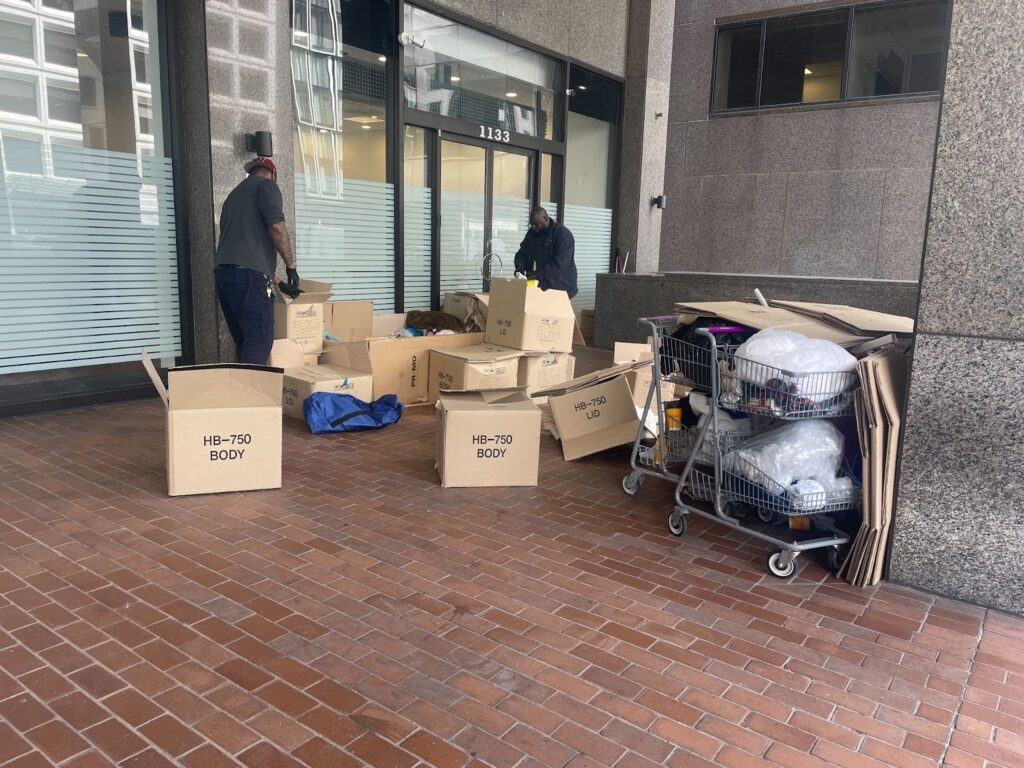Mayor Muriel Bowser’s administration cleared residents out of two tent encampments at the M Street and L Street underpasses near Union Station on May 13.
Garbage trucks, a skid-steer loader, and a mobile power washing machine, along with a crew of sanitation workers, gathered at the underpass on a cool afternoon for the “full cleanup.” While the effort coordinated by the Office of the Deputy Mayor for Health and Human Services was scheduled to begin at noon, volunteers and employees from various nonprofit homeless services organizations arrived several hours beforehand to help the encampment residents move. Some volunteers also provided coffee and breakfast food to the people being displaced.

Residents of each underpass temporarily moved their tents and belongings out, storing them on the adjacent street. Some people had accumulated furniture and larger items to help organize their temporary abodes into a home, such as shelving and a minifridge. Once one side of the underpass was vacated, city workers came in to remove and discard all unclaimed belongings, sweep garbage, and powerwash the sidewalk. A pesticide to target rats, in the form of a large pellet, was shot into holes near the encampments where the rodents were known to nest. The holes were then closed. This is the most effective strategy for targeting rats, according to a D.C. Rodent Control Division employee on the scene, who said the poison would not affect squirrels, birds, or other animals.
The north side of L Street NE was cleaned first. Residents began returning their tents while the process began at the M Street underpass around the corner, after which the government returned for the second side of L Street. All parties involved — government workers, the approximately 60 people living in the tents in the two underpasses, and people volunteering to help them move their tents — worked methodically and without incidents, suggesting a process that all are accustomed to. The mutual aid volunteers and nonprofit employees who were present from start to finish put in 8-hour shifts to ensure residents were able to move and retain their belongings.

Cleanups like this were for a time a common occurrence at this location. There were 23 “engagements” of the city’s encampment protocol at the NoMa underpasses in 2019, when people were also encamped in the K Street NE underpass. Most were full cleanups, where residents are forced to move their tents outside of the cleanup zone and where anything left behind is thrown out, as opposed to “trash-only” engagements, where only things identified as garbage are thrown out and residents can stay where they are.
The pace slowed in 2020 due to the COVID-19 pandemic. CDC guidelines issued in May 2020 recommended that local governments not clear out encampments while the pandemic went on. “Clearing encampments can cause people to disperse throughout the community and break connections with service providers,” the CDC said. “This increases the potential for infectious disease spread.”

The city engaged its protocol to assess and remove encampments only 11 times over the course of the year. This included an effort in January 2020 that resulted in permanent closure of the K Street underpass to tents, a policy suggested by the NoMa Business Improvement District the previous year. The cleanup schedule on the Deputy Mayor for Health and Human Services website indicated that the May 13, 2021 event would be the second engagement and the first first full cleanup scheduled for either underpass so far in 2021. Of the seven engagements scheduled throughout the District in May, five were full cleanups; from January through April, less than half of all engagements were full cleanups.
The Office of the Deputy Mayor for Health and Human Services did not respond to questions about whether the frequency of full cleanups this month signals a change in the District’s COVID-19 “posture” for encampments. Mayor Bowser has lifted many COVID-related restrictions for businesses and activities and announced that all such restrictions will be lifted by June 11. For now, according to a document published by the deputy mayor’s office last year, “The District maintains the ability to conduct full cleanup engagements when trash-only engagements are insufficient to remove the public health and safety concerns. Additionally, the District maintains the ability to conduct an immediate disposition at an encampment if an immediate health or safety risk is present.”


As people experiencing homelessness continue to jostle for space that is partially protected from bad weather and is near transit and basic services, more and more housed people have moved to the gentrified area. The population has grown enough to warrant a potential new voting precinct and to influence the redistricting process that will begin this September.
At the end of the block where the L Street underpass cleanup took place, construction site signage on the south side of the street indicates that a 4-star hotel and 500 new apartments will be added there by the time the “NoMaCNTR” development is completed next year. “In 2022, people will converge upon a new DC experience to reside, stay, relax, socialize, dine, shop and more,” according to the project’s website, which also states that the average household income in the area is $133,000. The development, formerly called Storey Park, has been in the works for 10 years, according to the Washington Business Journal. Last year, the development team signed an agreement to lease one fifth of the planned apartments to Churchill Living, which the company will market as furnished units.
NoMaCNTR is one of 12 residential projects expected to add more than 3,700 apartments or condos to the area in the next two years, according to the NoMa BID website.

Queenie Featherstone and Eric Falquero contributed to this reporting








